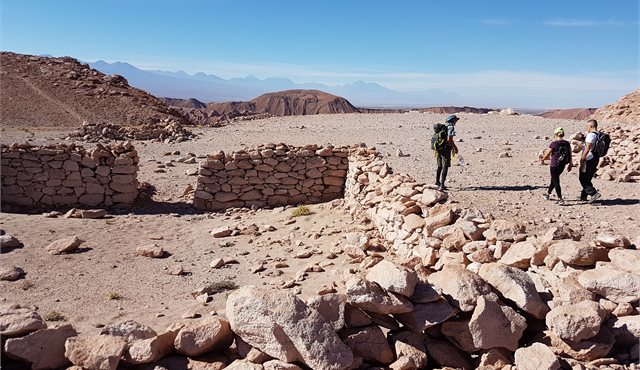We arrived in Quito in the evening and I was surprised I didn’t feel any effect of the altitude – yet. It wasn’t a long trip into town from the airport but a bit disorienting in the dark as I felt we were heading downhill but in fact we had been climbing. Quito sits in a valley surrounded by mountains and ecological reserves and the next morning we had a walking tour of the historic central city which was founded by the Spanish in 1534. I certainly noticed the altitude then – Quito is 2,580 metres (9,350 feet) above sea level – and I was puffing after just walking up a few steps.

Another day we took a gondola up the side of Pichincha Volcano and took in the view of the Valley of the Volcanoes: it was a great spot but you couldn’t walk far without puffing. Some members of our group got headaches at this height and there was the opportunity to take flavoured oxygen which was a bit of fun and apparently did alleviate the headache. There is also a great view over the city from the hill of El Panecillo which has a 45-metre statue of the Madonna. If you are interested in history Quito is full of Inca culture and has one of the largest and best-preserved colonial-era centres (it’s a UNESCO World Heritage Site) in the Americas.

After a couple of days we headed to Mashpi Lodge which is situated in the Cloud Forest northwest of Quito and at a lower altitude. Mashpi is in a remote location and the drive takes two to three hours and the last hour is over a bumpy road. It’s a fantastic place though and a worthwhile experience if you have time and enjoy bird-watching. You also need a reasonable level of fitness once you are there as there is a lot of trekking, but the lodge does tailor the experience even for wheelchair-bound clients.

The Mashpi area has a hummingbird sanctuary and we saw fabulous birds and butterflies. The guides are great at helping you get great photos and spotting the birdlife through the binoculars. We even saw a toucan! If you do the evening walk with the guides expect to see snakes and spiders; they are all poisonous but the guides know what they are doing. We had three nights at Mashpi Lodge which was just enough, but one more day would give you the opportunity to relax a bit more and enjoy the tranquility. Being in the Cloud Forest there is a high chance of rain, but wet-weather gear and gumboots are supplied along with walking sticks if you want them. I also had a spa treatment at the lodge and the massage was excellent.

We then headed to the Galápagos Islands via two flights. The Galápagos are 1,000km offshore and I was surprised to see how populated they were as I was expecting barren islands and nothing else. There is a permanent population of 20,000 people, lots of tourist operators, shops, bars, restaurants and all the infrastructure to support the tourism.

On arrival you clear customs and it is best to have your drink bottle and walking shoes, sunhat and sunscreen at the ready as we headed straight to the tortoise sanctuary for a walk around and lunch. These animals are the famous large land-based tortoises and we had plenty of time with a guide as well as time on our own. We were anxious to get to sea though and after a couple of hours we headed to the marina to board our ship where a fabulous surprise awaited us: there were sea lions everywhere, totally unfazed by humans.

Our ship was the Isabella II and we had an excellent experience, better than expected due to her age and the cabins, although basic, were all we needed, including our own en suite. The food was great and the staff were excellent. The ship’s knowledgeable guides and the playful sea lion pups we encountered during excursions also made for an extraordinary experience. We were there in August which is when the sea lions have their pups and it made for amazing snorkelling as they would come close; one of our group had a pup nose right up to the camera. If you are expert enough to dive down and somersault and twist and turn under the water the pups will copy you. I was waggling my fingers and a pup came right up to me as well.


One day we had just jumped in the water when our guide spotted whale spouts in the distance. He asked if we wanted to go and get closer, which of course we did. We climbed back in the Zodiacs and raced towards the whale. It spouted a few times and heaved itself out of the water. It was the size of a submarine and what an experience! Unfortunately it quickly disappeared and we returned to the ship.

We had a Zodiac shore landing each day and our guides took us on walks. On one of them we visited an albatross colony and saw them do a mating dance and I felt as though I was watching a David Attenborough documentary. We saw loads of iguanas which were piled up over each other on the beach and our guide had to find a way around them so we could continue our walk. These iguanas are waterloving and feed on seaweed growing on rocks under the water. They change colour in the sun as they warm up. That day we were looking for pelicans but were only lucky enough to see one. We also walked a lot up quite high hills with fabulous views back over the ocean and the ship. We climbed up to see red-footed boobies with their chicks and also saw plenty of blue-footed boobies as they are quite common.

When you are in the Zodiacs you never know what you might see: we had sea lion pups following us, we saw penguins which was unusual at that time of year, we saw numerous birds diving – it was just fantastic! I would recommend that you devote a week to seeing the Galápagos as the more time you have, the more you can see. We only had four nights but wow, what a fantastic four nights!








